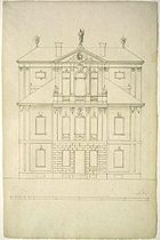
Kotowski Palace
Encyclopedia
Kotowski Palace was a 17th-century palace in Warsaw
, Poland
. It served as a main cloister building for sisters of Benedictine Sisters of Perpetual Adoration
.
building in Palladian style was designed by Tylman van Gameren
. In 1688 it was purchased by Queen Maria Kazimiera and transferred into a seat of Benedictines of the Blessed Sacrament. In 1688–92 the Kotowski residence was transformed into a church-cum-cloister by Tylman van Gameren. In the 18th century the monastery was enlarged. In about 1745 the new palace was built at the New Town Market Square and in 1771–79 the king Stanisław Augustus Poniatowski established a new building situated at the escarpment. Those two buildings were connected in 1788.
During the Second World War
, the building was used as a hospital. This made it a frequent target for bombing by the Germans in the Warsaw Uprising
. The palace was completely destroyed
and was never restored.
Warsaw
Warsaw is the capital and largest city of Poland. It is located on the Vistula River, roughly from the Baltic Sea and from the Carpathian Mountains. Its population in 2010 was estimated at 1,716,855 residents with a greater metropolitan area of 2,631,902 residents, making Warsaw the 10th most...
, Poland
Poland
Poland , officially the Republic of Poland , is a country in Central Europe bordered by Germany to the west; the Czech Republic and Slovakia to the south; Ukraine, Belarus and Lithuania to the east; and the Baltic Sea and Kaliningrad Oblast, a Russian exclave, to the north...
. It served as a main cloister building for sisters of Benedictine Sisters of Perpetual Adoration
Benedictine Sisters of Perpetual Adoration
The Benedictine Sisters of Perpetual Adoration are a congregation of nuns within the Benedictine Confederation. The original monastery was founded in 1874 by a group of five nuns, led by Sister Mary Anselma Felber, O.S.B., who came from the young monastery of Maria-Rickenbach in Switzerland...
.
History
It was built some time between 1682 and 1684 for Adam Kotowski and his wife Małgorzata Durant. A large, three-storied baroqueBaroque in Poland
The Polish Baroque lasted from the late 16th to the mid-18th century. As with Baroque style elsewhere in Europe, Poland's Baroque emphasized the richness and triumphant power of contemporary art forms. In contrast to the previous, Renaissance style which sought to depict the beauty and harmony of...
building in Palladian style was designed by Tylman van Gameren
Tylman van Gameren
Tylman van Gameren was a Dutch-born Polish architect and engineer who, at the age of 28, settled in Poland and worked for Queen Maria Kazimiera, wife of Poland's King Jan III Sobieski...
. In 1688 it was purchased by Queen Maria Kazimiera and transferred into a seat of Benedictines of the Blessed Sacrament. In 1688–92 the Kotowski residence was transformed into a church-cum-cloister by Tylman van Gameren. In the 18th century the monastery was enlarged. In about 1745 the new palace was built at the New Town Market Square and in 1771–79 the king Stanisław Augustus Poniatowski established a new building situated at the escarpment. Those two buildings were connected in 1788.
During the Second World War
World War II
World War II, or the Second World War , was a global conflict lasting from 1939 to 1945, involving most of the world's nations—including all of the great powers—eventually forming two opposing military alliances: the Allies and the Axis...
, the building was used as a hospital. This made it a frequent target for bombing by the Germans in the Warsaw Uprising
Warsaw Uprising
The Warsaw Uprising was a major World War II operation by the Polish resistance Home Army , to liberate Warsaw from Nazi Germany. The rebellion was timed to coincide with the Soviet Union's Red Army approaching the eastern suburbs of the city and the retreat of German forces...
. The palace was completely destroyed
Planned destruction of Warsaw
The planned destruction of Warsaw refers to the largely realised plans by Nazi Germany to completely raze the city. The plan was put into full motion after the Warsaw Uprising in 1944...
and was never restored.

